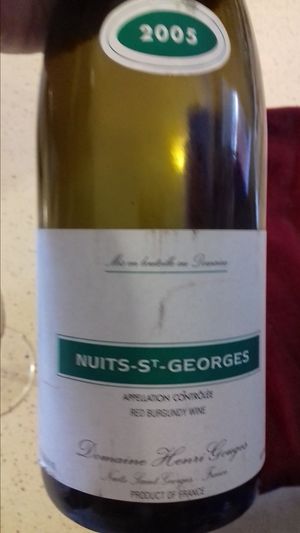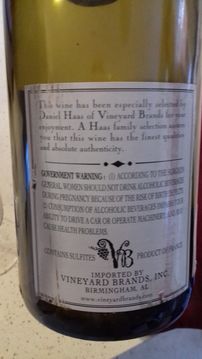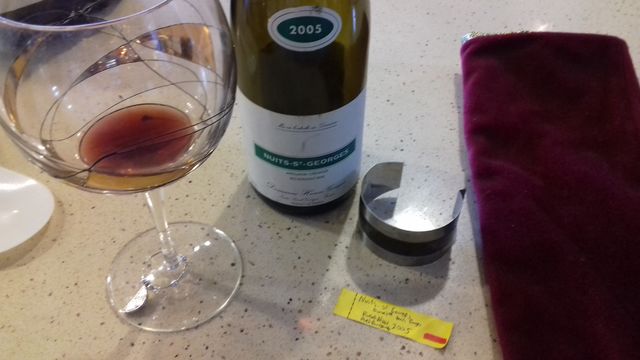Red Burgundy - 2005 - Domaine Henri Gouges

-
File:NuitsStGeorges2005BurgundyBack.jpg
-
File:NuitsStGeorges2005Burgundy.jpg
April purchased this after reading a Tastings by Dorothy J. Gaiter and John Brecher column on Friday, March 7th, 2008. Quote below is the article. Consumed on February 18th, 2018 along with Megan, JoAnne, and Rico. Everyone thought it was a good wine, and it somewhat spoiled April on what Pinot Noir can be, as it was a darker color and had relaxed with age.
Notes elsewhere say, "$55 from Steve's(200808)", and April believes this would the Steve's at 3618 University Ave, Madison, WI 53705, as she has a vague recollection of purchasing it there. The purchase date of August 2008 seems a few months too late, but that's what the note says, and the note is from no later than 2010.
The Right Stuff
2005 Burgundy Shows How Good This Famed French Red Wine Can Be
Drop everything. Go to a good wine store right now, buy a bottle of 2005 red Burgundy and open it for dinner tonight. Set aside some time to go back tomorrow to buy more to lay down for the future.
Whew. Is it hot in here or is it us? Burgundy can get us pretty worked up. To us--and to many wine lovers everywhere -- Burgundy, when it's right, is the world's most beguiling wine, with soulful tastes of velvety fruit and a slight hint of funk that can be quite romantic. Too often, however, Burgundy isn't right, so Burgundy lovers are used to heartbreak. In broad blind tastings for this column, we have suggested that you skip entire vintages of Burgundy. That was our advice for the 2003 vintage because too many of the wines tasted like they'd been manipulated to rescue them from the heat wave, which ruined a lot of Pinot Noir fruit.
Hope springs eternal in the breast of every Burgundy lover, however, so we decided to try the just-arriving 2005s. We focused on the wines of two areas: Volnay, a smaller area in the Côte d'Or, and Gevrey-Chambertin, a larger area in the Côte de Nuits area. There's nothing magical about these two appellations. It's just that we've liked each for decades, and we have found that a broad tasting of their wines has given us good insight into the quality of vintages.
We bought a large sampling of each from stores in four states. Because Burgundy is chopped up into small parcels of land and many producers, it's impossible to know which you might see. While there are some well-known names, such as Drouhin and Jadot, some of the most charming wines are made by very small producers who are lucky to get any of their wines into the U.S. Those unusual names are good to look for. We set our price limit at $80 because that gave us enough options for a large sample.
We tasted the wines in blind flights over several nights (Volnays with Volnays, Gevreys with Gevreys) and, put simply, they were terrific. This is the most consistently good vintage of red Burgundy we have tasted for this column. Overall, the Volnays were smoother, rounder, more velvety, while the gevreys had more minerals and more presence, befitting the favorite wine of Napoleon. What the wines had in common, again and again, was a sense of integrity. These wines tasted like great fruit grown in limestone-rich soil and thus touched us deeply in a very special way. And they had something extra this year: While they presented young, vibrant raspberry-cherry fruit on the top, they already gave hints underneath, and especially in the finish, of what they will ecome in time. There was an unusual depth, a sense of more serious underlying fruit, that we could taste. In fact, when John looked at Dottie and simply said, "47," we knew these were amazing because Dottie said she was thinking the same thing.
One of the most memorable bottles of Burgundy we've ever had was a 1947 (it was Pierre Ponnelle Vosne-Romanée Beaux-Months). It became for us a very important personal marker. Much as we already loved Burgundy, when we tasted that wine in 1989, we realized how special Burgundy really could be with serious age. When we tasted these, it was as though we could sense that, many years down the road, they will be as lovely as that 1947. We can offer no higher praise.
For one flight, Dottie roasted a chicken and we drank the wines with dinner after the initial tasting. Our favorite from that night was excellent. It was Domaine Henri Rebourseau Gevrey-Chambertin, which, in our notes, we'd given a high compliment: "Lovely, real Burgundy." At dinner, when we tasted it with the chicken, both of us swooned. Though young, the wine was even better with the chicken. We talked a lot about how the seeming simplicity of the wine -- lovely fruit in a glass -- and the seeming simplicity of the chicken spoke to each other in an extraordinary way. But, of course, the simplicity is an illusion. This is how Dottie makes her "simple" roast chicken:
"I take a young, fresh chicken from the refrigerator to let it warm up a bit and preheat the oven to 450. While that's happening, I slice some garlic cloves to place under the skin, ending up with six good-size slivers. I set aside two cloves to rub inside on the chicken's ribs and cut a medium-size onion in half. I also put aside about four dried bay leaves (if it's summer, I gather a little of everything in my herb patch -- oregano, sage and basil). I also melt some butter and pour some pepper and kosher salt into a bowl. After rinsing the bird and patting it dry, I life the skin carefully and place, salt, pepper, a sliver of garlic nd a bay leaf on each breast. Turning the chicken breast-side down, I do the same thing to the thighs. Basically, wherever I can place garlic, I will. In the cavity, I rub two garlic cloves along the ribs unitl they disintegrate and place the onion halves in there along with salt and pepper and herbs. Then I brush the entire bird with butter and sprinkle salt all over it. I roast it for about 50 minutes, or until drumsticks move easily, liquid runs clear and skin is as crispy as Zoë [our daughter] likes. When it's done, the skin with the bay leaves underneath looks a little like stained glass."
Our point is that Burgundy is just as "simple." When it comes to great Burgundy, like great roast chicken, the miracle is that it seems so darn simple -- hey, it's just grape juice. In fact, making wine as beautiful and ephemeral as a fine Burgundy requires the right land, good weather, centuries of experience and a very deft hand. All of those came together in the 2005 vintage. Oh, on on your way to the wine store, how about picking up a chicken?
--Melanie Grayce West contributed to this column.
The Dow Jones 2005 Burgundy Index
In a tasting of two types of red Burgundy from the 2005 vintage that cost less than $80, these were our favorites, but we found the wines so consisten that you can feel confident simply picking one up. These are delicious now but will age beautifully for many years. Burgundies, which are made from Pinot Noir, go well with a wide variety of foods, from roast chicken to roast beef to grilled salmon.
Volnay Vincent Girardin Premier Cru "Les Caillerets." $63.15. Delicious Best of tasting. Rich, smooth and velvety, with a long, warming finish and still some punch from its youth. Chocolate, blackberries, blueberries, cherries and lilacs -- yum.
Joseph Drouhin. $37.99. Very Good. Best value. Smooth and lovely, with great fruit and very attractive blueberry-blackberry tastes. Rich, yet light on its feet. Quite romantic and nicely complex.
Domain Jean-Marc Bouley Premier Cru "Clos de Chênes." $55. Very Good Earthy, fruity and very real, with raspberry fruit and a long, mineral finish. Terrific in a decade or two.
Gevrey-Chambertin Domaine Henri rebourseau. $49.95. Very Good/Delicious Best of tasting. Still quite tight, but already showing awesome fruit and plenty of depth. Lovely wine that would make any meal an event.
Maison Champy "Vielles Vignes." $39.95. Very Good/Delicious. est value. Rich but not overly fruity, with black-tea astringency and plenty of earthiness. Some bittersweet chocolate. Classy and restrained, with many layers of interest. We also liked Maison Champy Premier Cru "Les Cazetiers" ($79.95), especially to lay down.
Bouchard Père & Fils. $44.05. Very Good. Relaxed and balanced. Easy and elegant and more approachable now than others. great with salmon.
Domaine Geantet-Panslot. $49.99. Very Good. Earthy, cherry-like fruit, with a lightness about it that's charming. Dainty, ephemeral and totally fetching.
Domaine Heresztyn "Vieilles Vignes." $59.95. Very Good. Fleshy, like a very ripe plum. Quite satisfying and complete, with a smooth finish.
NOTE: Wines are rated on a scale that ranges. Yech, OK, Good, Very Good, Delicious, and Delicious! These are the prices we paid at wine stores in North Carolina, Texas, New Jersy and New York. We paid $65 for Bouley, but this price appears to be more representative. Prices vary widely.

